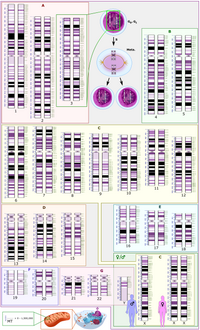
Loss of the IR region in conifer plastomes: Changes in the selection pressure and substitution rate of protein‐coding genes
Sign Up to like & getrecommendations! Published in 2022 at "Ecology and Evolution"
DOI: 10.1002/ece3.8499
Abstract: Abstract Plastid genomes (plastomes) have a quadripartite structure, but some species have drastically reduced or lost inverted repeat (IR) regions. IR regions are important for genome stability and the evolution rate. In the evolutionary process… read more here.
Keywords: rate; coding genes; selection pressure; selection ... See more keywords

The Emerging Role of Long Noncoding RNAs in Human Disease.
Sign Up to like & getrecommendations! Published in 2018 at "Methods in molecular biology"
DOI: 10.1007/978-1-4939-7471-9_6
Abstract: Only a small fraction of the human genome corresponds to protein-coding genes. Historically, the vast majority of genomic sequence was dismissed as transcriptionally silent, but recent large-scale investigations have instead revealed a rich array of… read more here.
Keywords: long noncoding; emerging role; disease; protein coding ... See more keywords

Gene regulation of mammalian long non-coding RNA
Sign Up to like & getrecommendations! Published in 2017 at "Molecular Genetics and Genomics"
DOI: 10.1007/s00438-017-1370-9
Abstract: RNA polymerase II (Pol II) transcribes two classes of RNAs, protein-coding and non-protein-coding (ncRNA) genes. ncRNAs are also synthesized by RNA polymerases I and III (Pol I and III). In humans, the number of ncRNA… read more here.
Keywords: transcription; long non; non coding; coding rna ... See more keywords

Genes dysregulated in the blood of people with Williams syndrome are enriched in protein-coding genes positively selected in humans.
Sign Up to like & getrecommendations! Published in 2019 at "European journal of medical genetics"
DOI: 10.1016/j.ejmg.2019.103828
Abstract: Williams syndrome is a complex condition resulting from the heterozygous deletion of nearly 30 genes in chromosome 7. However, precise genotype-to-phenotype mappings are not available for most of its distinctive features. Because WS entails changes… read more here.
Keywords: enriched protein; protein coding; williams syndrome; dysregulated blood ... See more keywords

Circadian analysis of the mouse retinal pigment epithelium transcriptome.
Sign Up to like & getrecommendations! Published in 2020 at "Experimental eye research"
DOI: 10.1016/j.exer.2020.107988
Abstract: The presence of a phagocytic peak of photoreceptor outer segments by the retinal pigment epithelium (RPE) one or two hours after the onset of light has been reported for several diurnal and nocturnal species. This… read more here.
Keywords: protein; analysis; non protein; protein coding ... See more keywords

Long-term evolutionary DNA methylation dynamic of protein-coding genes and its underlying mechanism.
Sign Up to like & getrecommendations! Published in 2018 at "Gene"
DOI: 10.1016/j.gene.2018.07.051
Abstract: DNA methylation is an important type of epigenetic modifications for the maintenance of genome functionality and stability. Although there are many studies on DNA methylation patterns, mechanisms, and functions, no study has focused on the… read more here.
Keywords: protein coding; methylation; dna methylation; coding genes ... See more keywords

Five new mitogenomes of Phylloscopus (Passeriformes, Phylloscopidae): Sequence, structure, and phylogenetic analyses.
Sign Up to like & getrecommendations! Published in 2019 at "International journal of biological macromolecules"
DOI: 10.1016/j.ijbiomac.2019.12.253
Abstract: The genus Phylloscopus belongs to the order Passeriformes and subfamily Phylloscopinae within the family Sylviidae. Phylloscopus, a small insectivore widely distributed in the old world, includes 66 species and 112 subspecies. We identified five new… read more here.
Keywords: new mitogenomes; five new; phylloscopus; protein coding ... See more keywords

A plant CitPITP1 protein-coding exon sequence serves as a promoter in bacteria.
Sign Up to like & getrecommendations! Published in 2021 at "Journal of biotechnology"
DOI: 10.1016/j.jbiotec.2021.07.011
Abstract: Genetic manipulation of plant genes in prokaryotes has been widely used in molecular biology, but the function of a DNA sequence is far from being fully known. Here, we discovered that a plant protein-coding gene… read more here.
Keywords: plant; serves promoter; citpitp1; protein coding ... See more keywords

Genome-wide codon usage pattern analysis reveals the correlation between codon usage bias and gene expression in Cuscuta australis.
Sign Up to like & getrecommendations! Published in 2020 at "Genomics"
DOI: 10.1016/j.ygeno.2020.03.002
Abstract: The protein-coding genes and pseudogenes of Cuscuta australis had the diverse contribution to the formation and evolution of parasitism. The codon usage pattern analysis of these two type genes could be used to understand the… read more here.
Keywords: usage bias; protein coding; codon usage; gene expression ... See more keywords

Genetic associations of protein-coding variants in human disease
Sign Up to like & getrecommendations! Published in 2022 at "Nature"
DOI: 10.1038/s41586-022-04394-w
Abstract: Genome-wide association studies (GWAS) have identified thousands of genetic variants linked to the risk of human disease. However, GWAS have so far remained largely underpowered in relation to identifying associations in the rare and low-frequency… read more here.
Keywords: genetic associations; associations protein; disease; coding variants ... See more keywords

Whole-transcriptome analysis of atrophic ovaries in broody chickens reveals regulatory pathways associated with proliferation and apoptosis
Sign Up to like & getrecommendations! Published in 2018 at "Scientific Reports"
DOI: 10.1038/s41598-018-25103-6
Abstract: Broodiness in laying hens results in atrophy of the ovary and consequently decreases productivity. However, the regulatory mechanisms that drive ovary development remain elusive. Thus, we collected atrophic ovaries (AO) from 380-day-old broody chickens (BC)… read more here.
Keywords: lncrna transcripts; atrophic ovaries; proliferation apoptosis; broody ... See more keywords